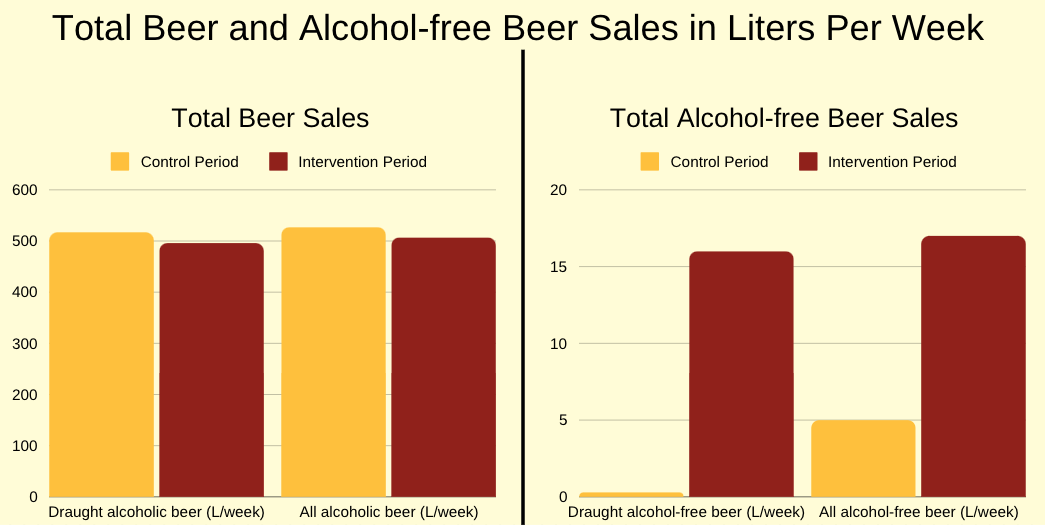The DRAM, Vol. 20(7) – The effect of introducing alcohol-free beer on alcohol sales in English pubs and bars
Alcohol use is associated with numerous diseases and health conditions worldwide. Public health workers have examined ways to reduce alcohol consumption, including increasing the cost of alcohol, restricting alcohol advertising, and educating people about the harms associated with alcohol consumption. A recent approach that some people have adopted is to provide alcohol-free products (e.g., mocktails) in spaces that traditionally serve alcohol. This week, The DRAM reviews a study by Katie De-Loyde and colleagues that tested whether introducing alcohol-free beer options decreases alcohol sales in English bars and pubs.
What was the research question?
What effect does introducing alcohol-free beer have on total alcohol sales and overall revenue at English bars and pubs?
What did the researchers do?
The researchers used a four-period randomized crossover design. In this case, this meant that all participating bars and pubs engaged in two time periods in which they sold alcohol-free beer (the control periods) and two time periods in which they did not sell alcohol-free beer (the intervention periods). Each time period lasted for two weeks. The study lasted a total of eight weeks. The time periods in which participating venues either did or did not sell alcohol-free beer were randomized. When venues were randomly assigned to sell alcohol-free beer, they removed one draught alcoholic beer and replaced it with a non-alcoholic beer. Venues were encouraged to advertise the alcohol-free beer in the same way they would any new beverage.
What did they find?
In total, fourteen venues participated in the study for its eight-week duration. There was a 3% reduction in alcohol sales during the weeks in which venues sold an alcohol-free beer in place of one of their draught beers. Despite this, there was 1% revenue increase during the times in which alcohol-free beer was available. Specifically, the pubs earned an average of £6333 during the weeks they did not sell alcohol-free beer and £6394 when they did. See Figure for the specific amount of alcohol sold and alcohol-free beer sold during the study period.

Figure. This Figure, adapted from De-Loyde and colleagues, depicts the total amount of beer and alcohol-free beer sold during the study period. Click image to enlarge.
Why do these findings matter?
The results of the study suggest that including an alcohol-free beer in place of a draught beer decreases alcohol sales (and thus consumption) while also increasing total revenue in English bars and pubs. A strength of this intervention is its minimalistic nature. That is, there is very little that venues would need to do in order to adopt the intervention. This is important because it means that there is a better chance that the intervention could be adopted by a wide number of venues, which could greatly reduce alcohol consumption.
Every study has limitations. What are the limitations in this study?
This intervention was tested in a small number of locations. This could mean that effects might differ by geographical location. For instance, areas with a high socioeconomic status might be more or less likely to want alcohol-free beer compared to areas that have a lower socioeconomic status. More testing is needed to see whether geographic effects influence the effects of alcohol-free beer availability on alcohol consumption and revenue. Another limitation is that the researchers used alcohol sales as a proxy measure for alcohol consumption. While it can be inferred that less alcohol was consumed, the results of the study cannot definitely indicate that less alcohol was actually consumed during the intervention periods.
For more information:
The National Institute on Alcohol Abuse and Alcoholism has tips and resources for people struggling with problem drinking. For additional drinking self-help tools, please visit our Addiction Resources page.
— Seth McCullock, PhD